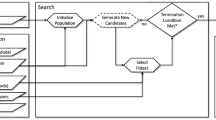Abstract
Combinatorial evolution – the creation of new things through the combination of existing things – can be a powerful way to evolve rather than design technical objects such as electronic circuits. Intriguingly, this seems to be an ongoing and thus open-ended process creating novelty with increasing complexity. Here, we employ combinatorial evolution in software development. While current approaches such as genetic programming are efficient in solving particular problems, they all converge towards a solution and do not create anything new anymore afterwards. Combinatorial evolution of complex systems such as languages and technology are considered open-ended. Therefore, open-ended automatic programming might be possible through combinatorial evolution. We implemented a computer program simulating combinatorial evolution of code blocks stored in a database to make them available for combining. Automatic programming in the sense of algorithm-based code generation is achieved by evaluating regular expressions. We found that reserved keywords of a programming language are suitable for defining the basic code blocks at the beginning of the simulation. We also found that placeholders can be used to combine code blocks and that code complexity can be described in terms of the importance to the programming language. As in a previous combinatorial evolution simulation of electronic circuits, complexity increased from simple keywords and special characters to more complex variable declarations, class definitions, methods, and classes containing methods and variable declarations. Combinatorial evolution, therefore, seems to be a promising approach for open-ended automatic programming.
Access this chapter
Tax calculation will be finalised at checkout
Purchases are for personal use only
Similar content being viewed by others
References
Arthur, W.B.: The Nature of Technology: What it is and How it Evolves. Free Press, New York (2009)
Arthur, W.B.: How we became modern. In: Sim, S., Seet, B. (eds.) Sydney Brenner’s 10-on-10: The Chronicles of Evolution. Wildtype Books (2018)
Arthur, W.B., Polak, W.: The evolution of technology within a simple computer model. Complexity 11(5), 23–31 (2006)
Banzhaf, W., et al.: Defining and simulating open-ended novelty: requirements, guidelines, and challenges. Theory Biosci. 135(3), 131–161 (2016). https://doi.org/10.1007/s12064-016-0229-7
Becker, K., Gottschlich, J.: AI programmer: autonomously creating software programs using genetic algorithms. arXiv (2017)
Bäck, T.: Evolutionary Algorithms in Theory and Practice. Oxford University Press, New York (1996)
Christen, P.: Modelling and implementing open-ended evolutionary systems. In: The Fourth Workshop on Open-Ended Evolution (OEE4) (2021)
Chun, W.H.K.: On software, or the persistence of visual knowledge. Grey Room 18, 26–51 (2005)
Cleaveland, J.: Building application generators. IEEE Softw. 5(4), 25–33 (1988)
Czarnecki, K., Eisenecker, U.: Generative Programming: Methods, Tools, and Applications. ACM Press/Addison-Wesley Publishing Co., New York (2000)
Czarnecki, K.: Perspectives on generative programming. In: SFB 501 “Development of Large Systems with Generic Methods” (2003)
Ebert, C., Cain, J., Antoniol, G., Counsell, S., Laplante, P.: Cyclomatic complexity. IEEE Softw. 33(6), 27–29 (2016)
Garg, A.: An approach for improving the concept of Cyclomatic Complexity for Object-Oriented Programming. arXiv (2014)
Harter, A.T.: Advanced techniques for improving canonical genetic programming. Missouri University of Science and Technology (2019)
Holland, J.H.: Genetic algorithms. Sci. Am. 267(1), 66–72 (1992)
Holland, J.H.: Signals and Boundaries: Building Blocks for Complex Adaptive Systems. The MIT Press, Cambridge (2012)
Klimek, P., Hausmann, R., Thurner, S.: Empirical confirmation of creative destruction from world trade data. PLoS ONE 7(6), e38924 (2012)
Koza, J.R.: Genetic programming as a means for programming computers by natural selection. Stat. Comput. 4(2), 87–112 (1994)
McCabe, T.J.: A complexity measure. IEEE Trans. Softw. Eng. SE–2(4), 308–320 (1976)
Ogburn, W.F.: Social Change: With Respect to Culture and Original Nature. B. W. Huebsch, New York (1922)
O’Neill, M., Spector, L.: Automatic programming: the open issue? Genet. Program. Evolvable Mach. 21(1), 251–262 (2019). https://doi.org/10.1007/s10710-019-09364-2
Parnas, D.L.: Software aspects of strategic defense systems. ACM SIGSOFT Softw. Eng. Notes 10(5), 15–23 (1985)
Pillay, N., Chalmers, C.K.A.: A hybrid approach to automatic programming for the object-oriented programming paradigm. In: Proceedings of the 2007 Annual Research Conference of the South African Institute of Computer Scientists and Information Technologists on IT Research in Developing Countries, SAICSIT ’07, New York, NY, USA, pp. 116–124. Association for Computing Machinery (2007)
Poli, R., Langdon, W.B., McPhee, N.F., Koza, J.R.: Genetic programming: an introductory tutorial and a survey of techniques and applications. University of Essex, UK, Tech. Rep. CES-475, pp. 927–1028 (2007)
Sarwar, M.M.S., Shahzad, S., Ahmad, I.: Cyclomatic complexity: the nesting problem. In: Eighth International Conference on Digital Information Management (ICDIM 2013), pp. 274–279. IEEE (2013)
Taylor, T.: Evolutionary innovations and where to find them: routes to open-ended evolution in natural and artificial systems. Artif. Life 25(2), 207–224 (2019)
Thurner, S.: A simple general model of evolutionary dynamics. In: Meyer-Ortmanns, H., Thurner, S. (eds.) Principles of Evolution: From the Planck Epoch to Complex Multicellular Life. The Frontiers Collection, pp. 119–144. Springer, Heidelberg (2011). https://doi.org/10.1007/978-3-642-18137-5_4
Thurner, S.: The creative destruction of evolution. In: Sim, S., Seet, B. (eds.) Sydney Brenner’s 10-on-10: The Chronicles of Evolution. Wildtype Books (2018)
Thurner, S., Hanel, R., Klimek, P.: Introduction to the Theory of Complex Systems. Oxford University Press, New York (2018)
Wikipedia contributors: Cyclomatic complexity — Wikipedia, the free encyclopedia. https://en.wikipedia.org/w/index.php?title=Cyclomatic_complexity&oldid=1054490449 (2021). Accessed 19 Nov 2021
Author information
Authors and Affiliations
Corresponding author
Editor information
Editors and Affiliations
Rights and permissions
Copyright information
© 2022 The Author(s), under exclusive license to Springer Nature Switzerland AG
About this paper
Cite this paper
Fix, S., Probst, T., Ruggli, O., Hanne, T., Christen, P. (2022). Open-Ended Automatic Programming Through Combinatorial Evolution. In: Abraham, A., Gandhi, N., Hanne, T., Hong, TP., Nogueira Rios, T., Ding, W. (eds) Intelligent Systems Design and Applications. ISDA 2021. Lecture Notes in Networks and Systems, vol 418. Springer, Cham. https://doi.org/10.1007/978-3-030-96308-8_1
Download citation
DOI: https://doi.org/10.1007/978-3-030-96308-8_1
Published:
Publisher Name: Springer, Cham
Print ISBN: 978-3-030-96307-1
Online ISBN: 978-3-030-96308-8
eBook Packages: Intelligent Technologies and RoboticsIntelligent Technologies and Robotics (R0)




